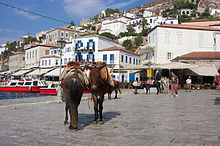| Athens Αθήνα | ||
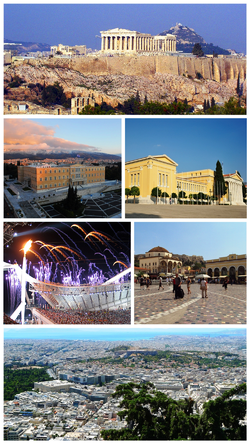 | ||
Coat of arms  | ||
| State | Greece | |
|---|---|---|
| Region | Attica | |
| Altitude | 70 - 338 m a.s.l. | |
| Surface | 3,808 km² km² | |
| Inhabitants | 3.737.550 (2011) | |
| Name inhabitants | Athenians | |
| Prefix tel | 30 210 | |
| POSTAL CODE | 104 xx-106 xx, 111 xx-118 xx, 121 xx-124 xx | |
Position
| ||
| Institutional website | ||
Athens is the capital of the Greece. It is located in the region Attica
To know
Athens (Ἀθῆναι in ancient Greek. Αθήνα in Greek demotic) is the name of the capital of the Greece. The city in its largest metropolitan area is close to 5,000,000 inhabitants (almost 50% of the Greek population). Today's Athens overlooks the Argosaronic gulf with a very long coastline and occupies a large basin limited to the east by Mount Imetto, to the north by Mount Pendeli and to the west by a series of low hills (Mount Aigaleo). To the north west stands the imposing bulk of the Mount Parnitha, a mountain with an alpine appearance on whose summit there is a large hotel with an adjoining casino.
According to an outdated theory, the name of Athens derives from the word "anthos" (άνθος = flower: Athens and Florence would therefore reveal a common etymology). Plato in his dialogues of Cratylus gives us his version. The name of the goddess Athena would mean "the divine mind" (i theos nus). Herodotus notes that in Egypt the inhabitants of Sais worshiped a deity named Neith whom they identified with Athena. (Timaeus XXI).
The name "Athens" is synonymous with democracy as the city was the cradle.
The goddess Athena, corresponding to the Latin Minerva, has been the patron deity of the city since its origins and the owl, an animal dear to the goddess, is its symbol and talisman.
Geographical notes
The city is bordered on three sides by Monte Imetto, Monte Parnita and Monte Pendeli; while within Athens there are twelve hills (the historic seven are: Acropolis, Areopagus, Philopappus Hill, Observatory Hill or Hill of the Muses, Pnyx, Lycabettus, Tourkovounia). The Acropolis and Lycabettus are the most important. These hills offer a refuge from the noise and bustle of the busy city streets, offering beautiful views as far as the Saronic Gulf, Athens' border with the Aegean Sea on the south side. The streets of Athens (marked in Greek and English) merge imperceptibly in it Piraeus, the ancient and still lively port of the city.
When to go
Spring and late autumn are the best times to visit Athens. Summer can be extremely hot and dry during heat waves, but this rarely happens. Winter is definitely low season, with the occasional rainy or snowy day, but also the ideal time to save money while enjoying the city without many other tourists.
While rush hour traffic can be a little smog on the main roads, on the sunniest days the skies are blue. The main reason attributed to Athens' pollution is due to the fact that the city is surrounded by mountains and is located in a hollow that does not allow smog to escape. Government restrictions on diesel vehicles in Athens and early 1990s initiatives to improve car emissions have contributed greatly to improving atmospheric conditions in the area.
Background
| The quality of Athenian statuary |
 Statue of Aphrodite When you visit the Archaeological Museum of Athens, but also the other museums of the city, you are struck by the beauty and sculptural quality of the statues and bas-reliefs. This feature is appreciated even more if you are familiar with the Roman statuary, or with the Greek Italian one exhibited in the museums of the Bel Paese and in the European ones. The skill of Athenian artists (even compared to that of other parts of the Greece) was known since ancient times and praised in art history books. Live even those who are not an expert can guess the extreme naturalness and dynamism of the shapes compared to the much more static ones we are used to. |
The first prehistoric settlements were built in 3000 BC. around the Acropolis hill. According to legend, the king of Athens, Theseus, unified the ten tribes of ancient Athens into one kingdom around 1230 BC. This process of synecism, or the unification of several villages in a single inhabited center, led to the creation of the largest city-state (polis) of mainland Greece, but also created a larger class of people excluded from political life by the nobility.
In the seventh century BC social unrest had spread and theAreopagus he appointed Draco to draft a new code of strict laws (hence the term "draconian"). When he failed, he was appointed Solon, with the mandate to create a new constitution (594). This was the great beginning of a new social revolution, which was the result of democracy under Clisthenes (508).
In the 5th century BC, Athens reached the pinnacle of its fame. It was the most powerful Greek city-state and became the center of Greek cultural life, favoring among the greatest cultural advances in ancient history. Fields of study such as science, philosophy, history and medicine were first developed by Athenian scholars in this period, known as the "golden age" of Athens.
Later, Athens became part of the under Macedonian empire Alexander the Great, and later part of theRoman Empire. Although he was no longer politically significant, his intellectual reputation gave him special status until, in the year 529, Emperor Justinian ordered the academies of Athens closed, and the intellectual center of the empire moved to Constantinople.
Athens was thriving and prosperous during the Crusades, actually benefiting from Italian trade during this period. However, this fruitful period was short-lived, as Greece suffered severe consequences under theOttoman Empire, only to recover in the nineteenth century as the capital of independent Greece. In modern times, the urban area of Athens has grown to a population of 3 million. Athens has developed into a large and vibrant city, but as a result it also suffers from congestion, pollution and poverty.
The city hosted i 2004 Summer Olympic Games. While most of the sports facilities were located outside the city, in various locations in Attica, the entire urban area of Athens underwent major lasting changes that improved the quality of life for visitors and residents. In addition to the excellent transport infrastructure that was completed in time for the Olympics (from new highways to light rail systems), the historic city center has undergone a major refurbishment. The most important projects are the Unification of the archaeological sites (which connects the ruins and the monuments of the classical era of the city with each other through a network of pleasant pedestrian streets) and the restoration of the picturesque neoclassical neighborhoods of Thissio is Pláka.
How to orient yourself

In Athens, the signs of the streets and stations also show the names in Latin letters so you will at least be able to know where you are. The only drawback is that the names of the streets and squares are repeated in the various districts so when searching for an address you will need to specify the name of the municipality to which you belong.
In general, the places of interest are not far from metro stations. There acropolis hill, where visible, it can constitute a point of reference as well as that of the Lycabettus.
Districts
Athens is a very large city and includes, in addition to center, about thirty municipalities; below are listed only the most interesting from a tourist point of view and grouped by area.

Other districts
- At the foot of the Mount Imetto along Viale Mesogeio there are 3 residential districts with no tourist interest except, perhaps, for that of Kesarians.
The eastern suburbs (in Greek: Anatolikà Proastia) - They are located between Viale Mesogio and the western slopes of Mount Imetto. They are quite pleasant neighborhoods especially in their upper part where members of the middle-upper middle class reside. Their interest in tourists is however very limited given the shortage of accommodation and can be taken into consideration only for their numerous taverns where, in the more traditional ones of Agia Paraskevì, they serve, even in summer, "paidakia", or grilled lamb cutlets sprinkled with plenty of lemon juice. They are described below only for a deeper understanding of the city.
- Papagou - A neighborhood that developed at the time of the military dictatorship (1967-1974) to offer accommodation to the families of senior officers of the Greek armed forces. Very well maintained but unfortunately there is no hotel. The town hall takes its name from Alessandro Papagos, a general who successfully repelled the aggression of theItaly fascist of September 1940 and who, in the postwar years, gave birth to a political movement modeled on the example of the one founded by Charles de Gaulle, holding the office of Prime Minister for a short period. The city hall administrators have successfully opposed government plans to build a tunnel in Mount Imetto where the metro from the airport would have to pass. In fact, it is enough to open a map of the city to realize that the metro makes a long and irrational tour in order not to disturb the sacrosanct right to peace of the inhabitants of Papagos. Moreover, the project of the "abhorred" railway tunnel was presented in 1992 by Tzannis Tzannetakis Deputy Prime Minister at the time but with a brilliant career in the Greek navy. This goes to show the might of the military class in Greece despite the military regime of the colonels ended in 1974. It is no coincidence that the skyscraper of the Greek secret services (EYP) whose cadres are mostly made up of military personnel.
- Cholargòs - Here Pericles was born! In fact, on the avenue leading to the neighborhood there is a tiny bust (epitome in Greek) dedicated to the most famous Athenian politician. Apart from this, Cholargòs is only a residential area with no trace of its past.
- Agia Paraskevi (Aghia Paraskevi) - A neighborhood once made up of a few villas and condominiums immersed in the fragrant woods of Mount Imetto and today wounded by building speculation. It is the only one of the eastern districts to have a couple of hotels. In the lower part of the district is the house-museum of Alessandro Iolas, an extravagant collector of works of art who died of AIDS in 1987. The museum project was never realized and, from the year of the collector's death to the present day , the exceptional collection of Iolas which included among other works works by Rauschenberg, Picasso is Man Ray it was systematically delapidated, evidently on commission and in the utter indifference of the Greek authorities in charge of their protection.
- Kesarianìofficial site - Unlike the previous ones, Kesarianì is a still very popular neighborhood located in a wooded valley of Mount Imetto further south of Papagos and closer to the center. It is a burial area with many cemeteries. In November 1988, the Orthodox funeral of Christina Onassis after his sudden death in Buenos Aires. It is not an exciting district despite the fact that the famous Byzantine monastery of the same name is located there.
Other districts always at the foot of Mount Imetto are Zografo (Zografou), where Panepistimioupoli (Accommodation for university students). Vironos (from Byron) dedicated to the famous English poet (pronounced Viron), Ilioupoli, much further south.
Suburbs
- Vari-Voula-Vouliagmeni It is a seaside resort with a vast beach, located in the southernmost point up to Cape Sounio. Although it is very busy in summer, Vari-Voula-Vouliagmeni can be considered because it is lively and offers various opportunities for recreation, day and night. It is located at the terminus of the trams that depart from Syntagma Square and pass through Glyfada. This municipality is highly recommended but you need a car for frequent commuting. It is also one of the most panoramic thanks to the two articulated promontories that form picturesque bays where luxury hotels are located. A little further on the coast road for Varkiza meets the locality Tria Limenakia where the most popular free beaches of Athens are located. (The first is predominantly gay in character)
How to get
By plane

- 1 Athens International Airport (Eleftherios Venizelos) (is in the locality of "Spata", 27 km east of center). It was inaugurated in 2001 to replace the old Ellinikò airport near Glyfada. As of 2012, flights from Italy were operated by the following companies:
- Aegean Airlines - From Milan-Malpensa and Rome-Fiumicino
- Alitalia - From / to Rome-Fiumicino
- easyJet - From Milan-Malpensa and Rome-Fiumicino
There's a tourist information office in Arrivals with the latest publications of the Tourist Information Department; these are useful for obtaining information on local festivals organized in Athens and Attica. There will also be a printed information booklet on the ferry from Piraeus and other ports in Attica.

There is also a small free museum on the top floor with the interesting history of Athens and a space for temporary exhibitions running at the following times: Tue-Sat 10: 00-13: 00 and 18: 00-20: 00, Sun 10: 00-13: 00 .
Trolleys are available at the airport, you will find them in the baggage hall upon arrival and they use coins in the same way as supermarket trolleys. Insert a euro coin to release a trolley; it is then obtained back by returning the carriage to its original position.
If you are staying in Athens for a short time, consider leaving some of your luggage in a luggage storage. It is managed by the Pacific Travel and is located at the end of the left wing, in the arrivals level. The drying times vary from 6 to 36 hours and the sizes vary from small to large. No automatic lockers can be found at the airport. There is also a locker service in Syntagma square in the center of Athens.
There is free Wi-Fi at the airport, which is limited to 45 minutes. Inside the airport there are indoor glass "smoking rooms", both in the departure counter area and for passengers landing before baggage claim.
- From the airport to the city

There are several ways to reach the center:
- In
 underground to the city center for € 10 (one way). Group tickets (2 or 3 people) are also available offering a discount (see below). The airport metro line is an extension of Line 3 (blue line) which leads to the central stations of Syntagma and Monastiráki. If you are headed elsewhere (for example at ports of embarkation for the islands) you will have to resort to buses.
underground to the city center for € 10 (one way). Group tickets (2 or 3 people) are also available offering a discount (see below). The airport metro line is an extension of Line 3 (blue line) which leads to the central stations of Syntagma and Monastiráki. If you are headed elsewhere (for example at ports of embarkation for the islands) you will have to resort to buses.
- From the airport, both the subway and suburban trains run from the same platform. If you are traveling to the city center, you should take the metro trains.
- Don't forget to validate your ticket before getting off the platform and getting on a train (there are validation machines at the top of the escalators in the ticket hall). Failure to validate your ticket at the start of your journey can result in a fine of up to € 200. Ticket inspectors are strict and will not hesitate to seek assistance from the police if you start to object.
.svg/220px-Athens_Metro_Map_(December_2013,_English).svg.png)
- Not all metro trains from Athens go to the airport; airport trains typically depart every half hour, while interval trains do not go all the way. Airport trains are indicated with an airplane logo on the front of the train, they are also announced by signs on the subway platform. It is useful to go to the metro station the day before, explain to the attendant (most speak English) when you need to be at the airport and ask what time you should take the airport train from that station. You can also get this information at the airport metro station, which has an office open at most hours with someone who speaks English. It is possible, but not necessary, to buy the ticket in advance; However, buying in advance means that you will not risk missing your train if you are at the last minute and you do not have the change for the ticket offices and you have to queue to buy it.
- With the suburban railway to Larissis train station for € 6 via change at Ano Liossia station. Suburban trains are not as fast as subway trains. A change from Ano Liossia to Line 2 (red) or from Doukissis Plakentias to Line 3 (blue) of the metro can take you to:
- Omónia and Syntagma stations (Line 2).
- Northern Greece and the Peloponnese, by train from Larissis station (line 2).
- Monastiraki and Syntagma stations (line 3).

- With the bus: X92 terminates in Kifisià, X93 at the Kifissos suburban bus station (KTEL), X94 at the metro station of the Ministry of Defense, X95 for Syntagma square, X96 for the port of Piraeus is X97 for the metro station of Dafni. The bus ride can take between 45 minutes and 1.5 hours depending on traffic and costs € 6. Buses, unlike the Metro, operate 24 hours a day.
- With the local bus: An unnamed bus leaves frequently in front of the Sofitel Hotel for Koropi metro station (€ 1.80, 15 minutes.) From there you can take the metro to Athens (€ 1.40.) According to the metro website the ride is € 10 but at the end of 2017 the station official confirmed that it is only € 1.40. You can also take local bus 308 from Koropi metro for the same price.
- By taxi: if you take a taxi be careful. Taxi rides to the center cost € 38 during the day and € 50 at night. Ask if the price includes toll charges.
It is advisable to get a free copy of the city transport map at the airport, in the city it is extremely useful.
Be aware that Greece has a long trade union tradition and that Greeks are never shy to go on strike, especially given the difficult economic situation the country finds itself in. Find out in advance about any strikes using the relevant websites.
On the train


- 1 Athens station (Stathmòs Larissis), Odos Domokou (It is located not far from Omonia square.). In reality, these are two stations. The other, known as the Peloponnese, is joined to the previous one by a pedestrian overpass. The red line of the Metro stops you. Suburban trains stop there Proastiakos line 1 coming from Athens International Airport and going to Corinth.
Trains also for Patras is Thessaloniki but to reach both locations it is much better to use the suburban buses.
By car
There are several routes that lead to Athens, according to the direction of origin:
- From the north is there
 which connects with Thessaloniki, Chalcis, Thebes.
which connects with Thessaloniki, Chalcis, Thebes. - From the east there
 with which you can reach Eleusis which then converges in the
with which you can reach Eleusis which then converges in the 
- From the west there
 to Corinth.
to Corinth.
By bus
Athens has two suburban bus stations:
- 2 KTEL Kifisoù (Bus 052 from the terminus in via Menandrou near Omonia square). At number 100 of Kifisoù avenue, almost at the intersection with Athinòn avenue (highway to Corinth). This is the largest station. It can be reached with the urban bus number 51 which terminates in via 3 via Menandro, close to Omonia square.
- 4 KTEL Liosion, Viale Liosion nº 260. Smaller than the previous one, the station only serves destinations in the Central Greece (including Delphi), ofEuboea, of the Thessaly (Volos is Katerini). It is 1 km from Kato Patissia metro station, on line 1 or green from Kifissia to Piraeus passing through the center (station of Monastiraki).
- 5 Regional bus terminus (KTEL ATTIKIS), via Mavromatèon (on the side of the public park "Pedio tou Areos"), ☎ 30 210 88 08 000. There is a bus service that connects the capital with various centers of theAttica. Interesting if you want to take the excursion to Cape Sounio or take a swim in some Attica beach. The terminus is just north of Omonia district. There are buses to / from the localities of Rafina (from where ferries and hydrofoils leave for some islands of the Cyclades including Mykonos), Nea Makri, But to you, Marathon, Aghia Marina.
International buses generally depart from the railway station (Stathmòs Larìssis). Links with Istanbul are managed by the Italian State Railways (OSE) and the company Varan. The buses ofOSE they depart every day at 19:00. Those of the Varan only on Mondays but always at 19:00. In the high season other races are added.
From the port of Piraeus ferries leave for the Aegean islands (Cyclades, Dodecanese is Crete). From the port of Rafina ferries and hydrofoils operate on the line I will go, Tino, Mykonos. Laurium it is another smaller port.
How to get around
By public transport
Public transport in Athens has improved by leaps and bounds over the past decade. The simple ticket from € 1.40 ("integrated") allows you to travel on any means of transport - metro, suburban trains, trams, trolleybuses, buses - with unlimited transfers anywhere within Athens (except the metro airport line to east of Doukissis Plakentias and airport bus) for 90 minutes. You can also get a daily ticket € 4.50 valid for 24 hours, or a tourist ticket 3 days for € 22 which includes a return trip to the airport. Finally, the Faliro ticket for 5 days from € 9. Further information on the different tickets can be found at the official site.
Meter
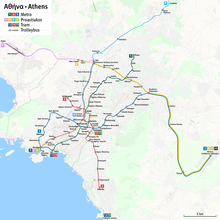
There Athens metro (open from 05:00 to 24:30, depending on races in the various stations) will do you great services to move from one point to another in the center or from this to the outer districts and suburbs, given the intense surface traffic and the low frequency of buses. Unfortunately it is extremely crowded so at least have the foresight to avoid rush hours.

Attiko metro is the name of the Athens metro. It currently has three lines:
 Line 1 (
Line 1 ( –[2] - The oldest line, underground only for a short distance at the center, useful for moving to the center but also if you want to embark on Piraeus for an Aegean island. In fact, it connects the port with the district of Kifisià passing through Omonia, Monastiraki, Thisio. It is marked with a green color
–[2] - The oldest line, underground only for a short distance at the center, useful for moving to the center but also if you want to embark on Piraeus for an Aegean island. In fact, it connects the port with the district of Kifisià passing through Omonia, Monastiraki, Thisio. It is marked with a green color Line 2 (
Line 2 ( – [3]) - Red in color, it connects the western district of Peristeri with Agios Dimitrios.
– [3]) - Red in color, it connects the western district of Peristeri with Agios Dimitrios. Line 3 (
Line 3 ( – [4]) - Blue in color, it connects the airport with the district of Chaidari
– [4]) - Blue in color, it connects the airport with the district of Chaidari
In metro stations: Agia Marina, Akropolis is Evangelismos, small museum spaces have been set up with some exhibits visible for travelers.
By tram


The trams will also be very useful if you want to reach the waterfront districts from the center or vice versa.Athenian Tramway Company operates three tram lines that connect the power station Syntagma square with the beach of Voula on one side and the port of Piraeus on the other. Thanks to these lines, the beaches of Athens have become easily accessible.
.svg/15px-Logo_of_the_Athens_Tram_(icon_only).svg.png) Line 1 (T1) It moves from Syntagma square and reaches Faliro, the tourist area of Piraeus (Microlimano) at the point where the stage of peace and friendship is found ("Irìnis kai Filias Stadium" in Greek).
Line 1 (T1) It moves from Syntagma square and reaches Faliro, the tourist area of Piraeus (Microlimano) at the point where the stage of peace and friendship is found ("Irìnis kai Filias Stadium" in Greek)..svg/15px-Logo_of_the_Athens_Tram_(icon_only).svg.png) Line 2 (T2) connects Syntagma square and arrives at the seaside resort of Voula passing through Glyfada. This is the line you will need the most.
Line 2 (T2) connects Syntagma square and arrives at the seaside resort of Voula passing through Glyfada. This is the line you will need the most..svg/15px-Logo_of_the_Athens_Tram_(icon_only).svg.png) Line 3 (T3) connects The Stadium of Peace and Friendship a Piraeus with Glyfada covering the entire arc of the Athenian coast.
Line 3 (T3) connects The Stadium of Peace and Friendship a Piraeus with Glyfada covering the entire arc of the Athenian coast.
On the train
With the occasion of the Olympic Games, Athens has equipped itself with a network of suburban trains that it did not have before. Trains serve the suburbs furthest from the center. The name in Greek is Proastiakòs " Suburban railways You will rarely use it unless you are itchy to see ancient Corinth. There are two lines:
- Line 1 connects the airport with the Athens railway station. (Larissa station) The route is 52 km long and has 17 stops. If our goal is the center Omonia or Syntagma it is better not to take this into account and use the fastest metro.
- Line 2 connects the airport with Corinth
By bus

You won't be able to rely heavily on buses especially on weekends and holidays. However, there is a night bus service, many of which terminate at the end of Viale dell'Accademia on the Omonia side (Platìa Koumoundourou). Here are some night lines:
- X14 - From Syntagma square to Kifisià
- 11 - Ano Patissia - Neo Pangrati - Nea Elvetia (trolleybus)
- 040 - from Piraeus to Syntagma Square.
- 500 - from Piraeus - to Kifisià (night only)
- X92, X93, X95, X96, X97 (to the airport)
O.A.S.A. (Athens Urban Transport Organization) is the company that manages urban road transport.
By funicular
To go up the Lycabettus hill it is possible to take the funicular.
- 6 Lycabettus funicular, Aristippou, 1, ☎ 30 21 0721 0701.
 € 6.50 return (Jan 2017).
€ 6.50 return (Jan 2017).  Mon-Sun: 09: 00-03: 00.
Mon-Sun: 09: 00-03: 00.
By taxi

The old way of standing on the curb and beckoning taxis to stop still applies. After that you have to say the name of your destination aloud. If the driver does not agree, he will shake his head and start off like a rocket and then it will be necessary to repeat the scene until someone picks us up. During the journey the driver will stop again to pick up other customers (always if it suits him) and therefore generally travel in company. Of course, if when we enter there is already another passenger, the taximeter will already be in operation and therefore we will have to observe what it marks and remember it and then deduct it from the final amount once we arrive at our destination. However, if you are not a bit familiar with the city, it is better to leave it alone because if we get on the wrong side of the sidewalk no one will ever pick us up. It is therefore better to use Radio Taxis:
- Radio Taxi "Athina 1", ☎ 30 210 9217942.
- Radio Taxi "Parthenon", ☎ 30 210 5323300.
- Radio Taxi "Express, ☎ 30 210 9934812.
- Radio Taxi "Ermìs", ☎ 30 210 4115200.
The initial cost is € 1.19, after which the meter rises to € 0.34 / km ("rate 1") or € 0.64 / km ("rate 2"), with a minimum charge of € 3 , 20. Rate 1 applies across the Athens city limits including the airport, while Rate 2 applies outside the city and from midnight to 05:00. Legal surcharges apply for calling a taxi via radio (€ 1.60), travel to or from the airport (€ 3.20) and heavy luggage (€ 0.32). Tips are not necessary, although it is common to round up to the nearest whole Euro.
Be aware that taxi drivers rarely obey all the rules of the road. Expect that if you are leaving Athens with an early flight, the driver will drive aggressively to get you there as quickly as possible.
Taxi fraud isn't as prevalent as it once was, but it still happens, so insist on the meter and make sure the rate is correct. In busy tourist spots, drivers try to bargain with a fixed fare that is incredibly high (e.g. € 20 for a short trip). In such cases, it is better to find another one and again insist on the value shown on the counter. If you believe you have been scammed, ask for a receipt (they are obliged to give one) and take the license plate number, then call the tourist police to report the driver at 171.
Apart from everything, the taxi in Athens is still a convenient means of transport and one should not hesitate to use it when necessary. The drivers are generally honest while the same cannot be said of their colleagues in the provinces.
In Athens it is present Uber.
By bike
Athens is not a friendly city for cyclists, as it does not have many cycle paths and motorists tend to drive rather aggressively. Nevertheless (or perhaps because of this) cycling in Athens has lately become a kind of political action (against), especially by young people with an alternative lifestyle. In general, tourists who are unfamiliar with the terrible Athenian traffic are advised not to use a bicycle as their primary means of transportation. But within the network of pedestrian streets in the historic city center, the routes are safe and can be very pleasant. A bike rental program is in its early stages; la sua stazione di bicicletta è a Technopolis.
A piedi

Ad eccezione di alcune strade turistiche, Atene è un posto incredibilmente sgradevole per camminare (rispetto ad altre città occidentali). L'orrendo traffico di Atene può far sì che per attraversare la strada in molte zone sia un problema, e camminare in diverse strade sia un'esperienza spiacevole di rumore e inquinamento. Le auto e le moto parcheggiate che bloccano i marciapiedi (illegali ma onnipresenti) possono anche rendere difficile una passeggiata. Il caldo umido dell'estate è estenuante e ci sono pochi parchi che offrono una via di fuga. Fortunatamente, gran parte dell'area afflitta dal traffico della città può essere evitata con un uso oculato della nuova metropolitana, che va nella maggior parte dei luoghi che un visitatore vorrebbe vedere o passeggiare.
Tuttavia, negli ultimi anni diverse strade centrali sono state pedonalizzate. Una passeggiata archeologica per la maggior parte senza auto inizia da via Vasilisis Amalias, passa davanti al nuovo museo dell'Acropoli, all'Acropoli, al teatro Herodion, a Thiseio (Apostolou Pavlou Str), alla via Ermou e termina nella famosa zona di Kerameikos (Ghazi) dove ci sono molti bar e club. A Plaka si possono anche fare camminate piacevoli, specialmente nei suoi tratti superiori, e in buona parte del Kolonaki. I Giardini Nazionali sono in grado di offrire una piacevole pausa dal caldo e dai rumori del centro città. Nota che anche in Plaka is Kolonaki, è probabile che la tua passeggiata venga interrotta da motociclette che scorazzano lungo le strette viuzze, distruggendo la pace e facendoti preoccupare della tua sicurezza.
What see

Monumenti dell'Antica Grecia
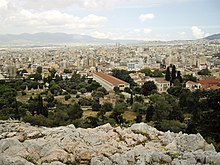
Una visita ad Atene è certamente l'occasione per visitare i più importanti e famosi edifici dell'Epoca classica. E' d'obbligo quindi una visita all'Acropolis dove si può ammirare il Partenone i cui fregi sono conservati al British Museum of London, l'edificio dell'Eretteo con la famosa loggia delle Cariatidi. L'esempio più importante di teatro greco è forse il Teatro di Dionisio utilizzato dai più importanti autori di teatro greci come Eschilo, Sofocle, Euripide, Aristofane is Menandro.
Degno di attenzione è l'agorà di Atene con i suoi edifici e templi come la Stoà di Attalo ricostruita a metà del XX secolo secondo il disegno originario e il ben conservato tempio di Efesto. Degna di nota l'ottagonale torre dei venti del 47 a.C. sfruttato come orologio solare, mentre il Monumento Coregico di Lisicrate venne eretto per ricordare la vittoria della squadra teatrale alle Dionisie. Da non trascurare anche il Tempio di Zeus Olimpio, la necropoli del Ceramico e la presunta Prigione di Socrate.

Monumenti romani
Per quanto Atene sia conosciuta soprattutto per i monumenti di epoca greca, non sono da sottovalutare i resti di epoca romana. È infatti presente l’agorà romana con la biblioteca di Adriano. Ma c’è anche l’arco di Adriano and the Monumento di Filopappo.
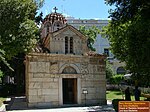
Chiese
Vi sono diverse chiese di pregio ad Atene come la Cattedrale di Atene del XIX secolo, la Kapnikarea del XII secolo, l’ancor più antica Chiesa Pantanassa, la Piccola Mitropoli, la Chiesa dei Santi Apostoli che risale al X secolo, dell’XI secolo la Agios Nikolaos Rangavas and the Chiesa di Aghia Triada. Per chi volesse visitare un luogo più tranquillo c’è il Monastero di Kesariani sulla collina dell’Imetto. Posta fuori dal centro, a Chaidari c'è anche il Monastero di Daphni, famoso per i suoi mosaici e iscritto tra i siti UNESCO.

Nella capitale vi sono anche alcune chiese cattoliche romane di cui ricordiamo solo la Cattedrale di San Dionigi.
Moschee
La presenza di moschee ad Atene testimonia il passato ottomano della città. Tra quelle ancora in piedi annoveriamo la Moschea Fethiye and the Moschea Tsisdarakis.
Museums
Atene è una città che offre una grande varietà di musei, molti di essi sono imperdibili soprattutto per il valore e l’importanza dei reperti in esposizione. Tra i musei archeologici abbiamo il Museo Archeologico Nazionale con i capolavori dell’arte micenea, l’arte classica e la statuaria antica, il Museo dell’Acropoli di Atene, the Museo di arte cicladica.
I musei di arte sono il Museo bizantino,
Una delle istituzioni museali più prestigiose realizzata con fondi privati sono di diversi musei Benaki: Il museo della cultura greca, il museo di arte islamica, la Galleria Ghika e quello al 138 Pireos.
Parchi e aree all'aperto
Risparmiati all'intenso traffico veicolare della città vi sono diversi punti in cui è possibile passeggiare in un ambiente più tranquillo grazie anche ai lavori di riqualificazione e alla nascita di percorsi pedonali in occasione delle olimpiadi del 2004. Da annoverare sicuramente la collina dell'aeropago e quella della Pnice.
Events and parties

- Festival di Atene e Epidauro, Panepistimiou 39. Si svolge da metà giugno a metà settembre. Il programma prevede spettacoli all'Auditorium (Megaro Mousikìs), negli impianti sportivi tra il Faliro e il Pireo alla fine del viale Andrea Singrou. Gli spettacoli in programma all'odeon di Erode Attico e al teatro di Epidauro non dovrebbero essere persi.
- Biennale di Atene (Biennale d’Arte contemporanea), 7, Pidnas Street, ☎ 30 210 52 32 222, @[email protected]. L’evento più importante nel panorama dell’arte contemporanea greca. L’ultimo evento si è tenuto nel 2017.
What to do


- 1 Collina di Licabetto. Un ottimo modo per spendere del tempo piacevolmente è visitare la collina a forma di guglia intorno alla quale si dispone il quartiere di Kolonaki. A parte le scale è raggiungibile in teleferica da via Aristipou, il costo del biglietto a/r è di €750. (Ottobre 2018). Per evitare in parte le scale si può fare un giro più largo passando da Syntagma. Con cartina alla mano.
- Tutte le informazioni possono essere trovate nella sezione dei trasporti.
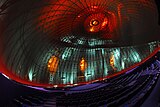

- Planetarium.

- Parco zoologico dell'Attica (Αττικό Ζωολογικό Πάρκο Σπάτων) (A Spata, nella zona dell'aeroporto internazionale).

Shopping

Sebbene sia una città enorme, Atene ha relativamente pochi centri commerciali o grandi magazzini; il piccolo negozio a conduzione familiare conquista ancora tutti. I souvenir sono ovviamente disponibili ovunque i turisti vadano. Altre opportunità di shopping sono antiquariato, riproduzioni di musei, ricami e altri prodotti di arte popolare e prodotti alimentari e bevande greche. Ecco una panoramica della scena dello shopping di Atene:
- Plaka è fiancheggiata da negozi di souvenir, la maggior parte dei quali vende souvenir economici, anche se ci sono alcuni negozi di qualità superiore. I prezzi possono essere alti per articoli di buona qualità.
- Ad Atene, il mercato delle pulci ha due significati. Il cartello accanto alla stazione di Monastiraki all'inizio di Ifaistou Street afferma che stai entrando nel "mercato delle pulci di Atene". La strada è fiancheggiata da negozi di seconda mano e eccedenti di ogni tipo. Pochi di loro sono di grande interesse per il visitatore, anche se verso l'estremità ovest della strada ci sono alcuni negozi interessanti che vendono vecchi libri, poster e registrazioni di musica greca e di altro tipo. Il vero mercato delle pulci si svolge la domenica mattina a Plateia Avissinia, all'estremità occidentale di via Ifaistou. C'è un incredibile assortimento di oggetti usati, oggetti d'antiquariato e roba inutile.
- La distilleria Vrettos (vedi sotto) vende bottiglie di ouzo autoprodotto e altri liquori.
- Kolonaki è la zona commerciale, alla moda e artistica. Kolonaki offre la solita gamma di negozi per un quartiere di lusso; gallerie d'arte, boutique di abbigliamento alla moda e negozi di antiquariato sono comuni. L'area è piccola e insieme alle stradine a nord, tra cui Skoufa, Anagnostopoulou e la pedonale Tsakaloff, sono ideali per girovagare semplicemente. 7 Plateia Kolonaki (Piazza Kolonaki) ci sono anche molti negozi lungo le strade Patriarchou Ioakim e Haritos e le loro strade trasversali.
- Martinos, 50 Pandrossou. Tra tutti i negozi di souvenir e di seconda mano nella zona, al si distingue come un vero e proprio negozio di antiquariato, che offre articoli di alta qualità provenienti dalla Grecia e dal Mediterraneo orientale. I prezzi sono anche al top della gamma, quindi questo è un negozio per compratori antichi esperti nel mercato per fare qualche spesa seria. Ricorda che portare oggetti d'antiquariato fuori dalla Grecia e nel tuo paese potrebbe essere soggetto alle leggi di entrambi i paesi e accertarti di conoscerli prima di prendere qualcosa di vecchio.
How to have fun
Locali
La maggior parte dei locali notturni in centro è situata nei quartieri di Gazi e Psirì. I locali di Gazi e Psirì sono frequentati soprattutto da giovanissimi. D'estate parecchi chiudono i battenti ma non disperate: prendete il tram e andate a Glifada. Li troverete tutti lì e nel quartiere adiacente di Elliniko.
Più che il locale spesso ha valore il programma della serata. Un aiuto potrebbero fornirlo i settimanali "Athinorama" disponibile nelle edicole e on line (solo in greco) e "Time Out" che dovrebbe disporre di una sezione in inglese.
Spesso è inutile chiedere ragguagli al personale dell'albergo dove si alloggia perché sono pagati per indirizzare i loro ospiti in certi locali.
Di seguito una selezione di locali che andava per la maggiore nel 2013, divisi, come al solito, per zona:
- Cabal, Ιερά Οδός 41, Γκάζι, ☎ 30 210 6974350247, 30 210 6945391793.
- [link not working]Dream City (Club - Restaurant), Ιερά Οδός 30-32, Γκάζι.
- W (Mainstream club), Πειραιώς 130, Γκάζι, ☎ 30 210 3411410.
 Aperto dal giov al sabato.
Aperto dal giov al sabato. - MAMACAS (dance club), Persefonis 41, Athina 118 54, Grecia (Gazi), ☎ 30 210 3470280.
- [link not working]Socialista (night bar), Triptolemou 33, Gazi, Athens, GR..
- DEATHDISCO (Rock club, dark wave club), Ωγύγου 15 και Λεπενιώτου, Ψυρρή.
- SECOND SKIN (rock club), Πλ. Αγ. Αναργύρων 4, Ψυρρή.
- VENTI MARGARITAS (Night Club · Ristorante), Λεπενιώτου 20 (Ψυρρή).
- Χοροστασιον (rock club), Σκουλενίου 2, Πλατεία Κλαυθμώνος, 1ος όροφ.
- Six D.O.G.S (dance club), Avramiotou 6-8 (Monastiraki).
- Akrotiri (Quartiere di Ellinikò). Akrotiri lounge club occupa una magnifica posizione sul mare al riparo di un piccolo promontorio (Akrotiri significa appunto promontorio). È riportato da tutte le guide blasonate ed è uno dei pochi locali a resistere alle mode e ai gusti volubili degli Ateniesi. Funziona solo d'estate
Locali gay

La zona con maggiore concentrazione di locali gay è quella di Gazi e dell'adiacente quartiere del Botanico (Votanikòs) sulla via Sacra (Ierà odhòs). Altri sono sparsi nelle zone meno raccomandabili di Omonia ma anche sul lato sud del recinto archeologico del tempio di Zeus Olimpico. Molto affollata d'estate è la prima spiaggia di tria limenakia sul litorale di Vouliagmeni. Anche se si dispone di un'auto è consigliabile servirsi dei mezzi pubblici per raggiungerla onde evitare furti. È preferibile andarsene un'ora prima del tramonto e non seguire l'esempio di gruppetti di incoscienti che bivaccano sulla spiaggia fino a notte inoltrata.
Di seguito alcuni indirizzi:
- Valentino Club, Ευμολπιδών 33.
Where to eat
La capitale offre ogni opportunità culinaria. Bar e ristoranti sono listati negli articoli dei singoli distretti.
Where stay
I due campeggi di Atene sono situati nel distretto di Kifisià. Esiste un terzo campeggio dislocato nel sobborgo orientale di Peristeri, detto "Camping di Atene" (sito web). Per quanto più facilmente reperibile degli altri due (si trova sul viale Athinon n° 198 - 200, tratto urbano dell'autostrada per Corinto - Patrasso) è di gran lunga inferiore per qualità e servizi offerti. Almeno prima delle Olimpiadi il suo aspetto era quello di un campo profughi ma c'è da dire che i suoi prezzi permangono ancora oggi più che abbordabili. Dista 7 km dal centro (Piazza Omonia)
Gli alberghi invece, sono listati negli articoli dedicati ai distretti cittadini.
Safety
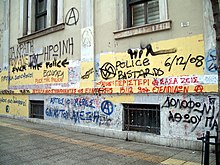
Atene è ritenuta ancora una città tranquilla dal punto di vista della sicurezza personale soprattutto nei quartieri al di fuori del centro. Se si risiede nella zona di Omonia bisogna fare attenzione agli extracomunitari che popolano i quartieri più infimi del distretto e che si spacciano per greci e talvolta si dedicano a piccoli furti di oggetti lasciati in auto parcheggiate in punti poco illuminati. Molti degli extracomunitari di Omonia fanno parte di potenti mafie che si dedicano con profitto allo sfruttamento della prostituzione e a ogni genere di traffici illeciti. Tra i più attivi gli Albanesi, i Georgiani, i Russians ma tutti si disinteressano di turisti che devono invece guardarsi dai piccoli scippatori. Tutto sommato anche Omonia rimane un distretto sicuro per chi i guai non se li va a cercare da solo ed è possibile passeggiare anche di notte nella piazza stessa, ma non nei quartieri intorno il cui aspetto per altro è ben poco rassicurante. Da sapere anche che la polizia greca è una delle più corrotte (e inefficienti) d'Europa e molti dei suoi elementi, malpagati, sono in combutta con la malavita locale.

Si segnalano casi di scippo nelle zone a maggiore flusso turistico. Piazza Monastiraki è un luogo in cui bisogna prestare molta attenzione perché maggiormente concentrati i casi di borseggio, ma anche nella linea della metro dall'aeroporto al centro di Atene.
Anche per Atene come per il resto della Greece è valido il consiglio di non appartarsi mai da soli o in coppia in zone isolate.
Prestare particolare attenzione agli scioperi o alle manifestazioni di protesta, spesso si trasformano in terreno di scontro tra la polizia e le frange più estreme con la possibilità di una degenerazione della situazione. In ogni caso è sempre meglio evitare di trovarsi nelle vicinanze.
How to keep in touch
Per districarsi tra i diversi orari di apertura dei vari monumenti e musei di Atene si può consultare questo sito essendo spesso gli orari del sito ufficiale greco non aggiornati.
Internet
In alcune aree della città è presente un wifi gratuito. Ulteriori informazioni riguardo all'accesso a all'ubicazione possono essere reperiti sul sito ufficiale.
Around

- Saronic Islands — Anche questa è un'escursione facile grazie ai frequenti traghetti in servizio sulla linea Salamis | Aegina | Angistri | Methana - Poros | Hydra | Spetses. Le isole più interessanti sono le ultime tre. Tenete presente però che nei week end d'agosto le navi sono superaffollate e potreste andare incontro a disagi di un certo peso. Meglio partire in un giorno feriale. Naturalmente anche in questo caso è meglio pernottare anche se è possibile rientrare in giornata.
- Mount Parnitha — Al centro di un parco nazionale sulla cui cima si trova un albergo vecchiotto con annesso il casinò di Atene. Purtroppo il parco è stato devastato da un terribile incendio.

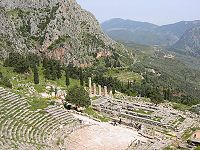
- Capo Sunio — La più classica delle escursioni da Atene, proposta da quasi tutte le agenzie locali. L'escursione si effettua in pullman percorrendo tutta la costa di Apollo e si arriva a Capo Sounio in tempo per godere lo spettacolare tramonto sul Mare Egeo. Potete andarci anche con uno degli autobus regionali che fa capolinea sulla via Mavromateon, poco più a nord di Omonia seguendo, anche a piedi, il tracciato della via 28 ottobre fino all'angolo con via Alexandras. Gli autobus sono fermi sul fianco del parco "Pedion tou Areos" (Campo di Marte in italiano)
- Delphi — Anche se non siete pratici potrete andare a Delphi da soli servendovi degli autobus regionali che partono dal capolinea al nº 260 della via Liosion. Vi sono 4 corse al giorno ma consultate il sito delle autolinee per maggior precisione [5] Difficilmente riuscirete a rientrare in giornata ad Atene a meno che non siate un tipo mattiniero e superattivo.
- Eleusis — La città è famosa per essere la sede del santuario dei Misteri Eleusini. Si può visitare l'area archeologica e il museo.


